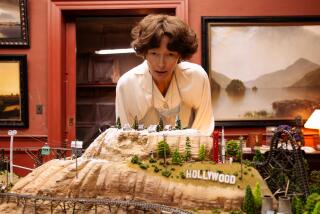Bringing film noir out of the shadows
- Share via
Eddie Muller and Alan K. Rode are on a mission -- to prevent our film-noir heritage from fading away.
Muller is founder and president of the Film Noir Foundation; Rode is on the board of directors. Every year they produce and host the Noir City Film Festival in Los Angeles and San Francisco. The 12th annual festival at the Egyptian Theatre, “Lust & Larceny,” opens Friday and continues through April 18. None of the films in the festival, which was co-programmed by the American Cinematheque’s Gwen Deglise and Grant Moninger, are available on DVD.
FOR THE RECORD:
Classic Hollywood: An information box accompanying the Classic Hollywood column in Wednesday’s Calendar section said one of the movies being shown Friday at the opening of the film noir festival at the Egyptian Theatre in Hollywood was “Hot Spot.” The correct title is “Tight Spot.” —
“The type of movie fan that goes down to the Egyptian Theatre is not the same type of person who is going to go in to see ‘Double Indemnity’ and ‘Out of the Past,’ because they have seen that,” says Rode. “We really believe the obscure films are what draw people into the Egyptian Theatre in Hollywood.”
Even though the official film-noir period was relatively brief -- 1941 through 1958 -- there were hundreds of films made in the genre during that time. Not only is film noir part of our culture, says Rode, “it is part of our history of the mid-20th century.
“When people went off to war and came back, the country left its adolescence and became adults. Watching ‘Andy Hardy’ and ‘The Thin Man’ movies after World War II didn’t cut it for audiences because of the life experiences of people.”
So heroes became anti-heroes; leading ladies turned into femme fatales who were not above murder to get what they wanted. The films were shot at night, on location. There was a lot of cigarette smoke, rain, booze and fedoras. Humphrey Bogart, Lawrence Tierney, Dick Powell and Richard Conte were among the kings of noir, with Barbara Stanwyck, Claire Trevor, Janis Carter, Cleo Moore and Joan Crawford the queens.
Unfortunately, a lot of these noir greats are disappearing from view. Both Rode and Muller hope the festival will lead the studios to restore, make prints and eventually release these films on DVD.
“I think we are kind of at a critical juncture,” says Muller. “Films do have a shelf life not just as a potentially perishable commodity, but in terms of what studios plan to do with them. I feel it’s so critical to find as many films as fast as possible. The industry is in such an amazing state of flux that some films owned by studios could [fall in] the cracks and they could disappear. If I waited another two years by the time we asked for a print, we could be told that the print had deteriorated to the point that it can’t be shown. If the studio doesn’t believe it has a commercial viability, then it would very well just disappear.”
Rights issues with a lot of these films have been a hornet’s nest for the foundation. Case in point, the opening-night film, 1951’s snappy “Cry Danger,” which UCLA Film & Television Archive preserved using funding from the foundation.
“We discovered that there was only a 16mm print that used to belong to star and producer Dick Powell, and that was deposited at Paramount,” says Rode. “Warner Bros. had the negative but they didn’t have the rights. So Warner Bros., to their credit, went and put the elements and the negative on deposit at the UCLA Film & Television Archive and then the Film Noir Foundation funded the restoration of the film.”
So what makes “Cry Danger,” a revenge tale set in downtown Los Angeles, so important in the film noir world?
“It was Dick Powell’s production,” says Rode, although Powell didn’t receive a formal producer’s credit. “It was directed by Robert Parrish, who was John Ford’s award-winning cutter [editor]. It was his first film. I think what really makes it special was the screenplay by Bill Bowers. He was one of the wittiest, most cynical, best writers of dialogue in the history of Hollywood.”
Plus, the supporting cast is top-notch, including Rhonda Fleming and Richard Erdman, who will be guests at the Egyptian on opening night.
“For those fans of the downtown-L.A. milieu, it is emblematic of what Los Angeles was like in 1950,” says Rode.
Another film caught in rights issues is the 1955 crackerjack “New York Confidential,” starring Broderick Crawford, which screens April 10. Rode describes “Confidential” as the “Holy Grail” of missing noir films.
“There’s a fellow named Kit Parker who owns a lot of films and puts his films on DVD,” says Rode. “Five years ago I went to dinner with Kit and I started talking about ‘New York Confidential’ and he said, ‘I have prints.’ He said, ‘Though the rights on this thing are so confused it will never get sorted out, and until it does I can’t do anything.’ About three months ago, Kit called and said, ‘I bought the rights, and the film is mine.’ ”
The film’s significance, says Rode, is that it is one of the noirs spawned by the infamous Kefauver hearings on organized crime.
“It’s a story of a mob kingpin as corporate executive, and he’s running everything from his Manhattan boardroom,” notes Rode. “He also has this tormented personal life with a mistress. The cast is wonderful. I mean, Broderick Crawford, Anne Bancroft, Marilyn Maxwell, Richard Conte. . . . It’s the hall of fame of film noir.”
More to Read
Only good movies
Get the Indie Focus newsletter, Mark Olsen's weekly guide to the world of cinema.
You may occasionally receive promotional content from the Los Angeles Times.










